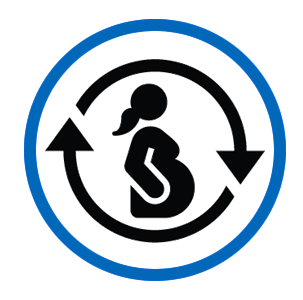Complete and quality antenatal care can prevent up to 27% of maternal deaths and increase by 7% the likelihood of a facility delivery.1 USAID: Ending Preventable Maternal Mortality: USAID Maternal Health Vision for Action
USAID
June 2014 This is a periodic behavior that needs to be practiced at least four times during pregnancy.

Antenatal Care
Pregnant women complete a full course of quality antenatal care (ANC)
Key Points from Global Research
- Improving a woman’s understanding of the services provided early in pregnancy can allow her to be more actively engaged in her pregnancy, solicit support where required and complete all recommended ANC visits.
- Leveraging and improving social and partner support to plan for all aspects of pregnancy, including ANC, can encourage women to complete all recommended ANC visits and better adhere to provider recommendations.
Behavior Profile Sample: Antenatal Care
A Behavior Profile is a summary analysis of each behavior. This sample draws from global evidence and illustrates the result of using the Create Behavior Profiles Tool to analyze factors, supporting actors and strategies and to ensure logical pathways exist between strategies proposed and factors related to the practice of the behavior. This sample may be used as a starting point or reference for creating Behavior Profiles.
| Improve maternal and child survival | |
|
Pregnant women complete a full course of quality antenatal care (ANC) Percentage of women who had a live birth in the three years preceding the survey who had 4+ antenatal care visits
|
Behavior Analysis |
Strategy | ||
|---|---|---|---|
STEPSWhat steps are needed to practice this behavior?
Click on any box |
FACTORSWhat factors may prevent or support practice of this behavior? These should be analyzed for each country context.StructuralAccessibility: Households are far from facilities Accessibility: Many women struggle to afford the cost inherent in multiple ANC visits and they do not see the value of their investment Service Provider Competencies: Many providers do not counsel mothers nor explain the benefits of the different services, tests and medication or supplements given during ANC SocialNorms: Many societies have strict cultural or traditional practices around disclosure of pregnancy, discouraging early ANC Family and Community Support: Pregnant adolescents are often reluctant to seek early care because of stigma and risk that they might be asked to leave school Family and Community Support: Often pregnant women are not encouraged or supported to complete all ANC visits InternalAttitudes and Beliefs: Women do not always perceive a value to multiple ANC visits, especially if they have already had one or more healthy pregnancies Knowledge: Most women say that ANC is important and most attend at least one visit |
SUPPORTING ACTORS AND ACTIONSWho must support the practice of this behavior?InstitutionalPolicymakers: Ensure teenage mothers can still attend school Policymakers: Ensure maternity care is accessible to most vulnerable via insurance schemes, conditional cash transfers (CCTs) or other financing Providers: Offer counseling and support to pregnant women during ANC including thorough explanations of services provided, importance of multiple visits and adherence to supplements or medication given HouseholdFamily Members: Actively participate in ANC and support woman, especially first-time mothers and adolescents, in all aspects of pregnancy and delivery planning |
POSSIBLE PROGRAM STRATEGIESHow might we focus our efforts based on this analysis?Enabling EnvironmentFinancing: Finance task-shifting and explore community-based service delivery such as iron folate supplements Policies and Governance: Encourage policies that permit pregnant teenagers to attend school Systems, Products and ServicesQuality Improvement: Train and support providers to emphasize the value of completing all ANC visits as well as active birth planning Demand and UseCommunication: Use targeted media, including SMS where possible, to tailor reminders and tips for pregnant women and their families on both ANC attendance and adherence to supplements like IFA Communication: Create pregnancy and new-mother groups to help mothers understand the benefit of care throughout pregnancy and the post-partum period Collective Engagement: Use traditional leaders and traditional birth attendants to encourage women to seek early and multiple ANC visits |
Global Status of Accelerator Behavior
Percentage of women who had a live birth in the three years preceding the survey who had 4+ antenatal care visits
Demographic and Health Survey, Malaria Indicator Survey, The DHS Program Indicator Data API, The Demographic and Health Surveys (DHS) Program
Selected Resources
Ending Preventable Maternal Mortality: USAID Maternal Health Vision for Action (2014)
Maternal and Neonatal Health Program Brief on Focused Antenatal Care
Saving Mothers Giving Life 2015 Mid-Initiative Report
WHO Opportunities for Africa's Newborns: Antenatal Care Chapter
WHO Policy Brief for Implementation of IPTp of Malaria in Pregnancy
